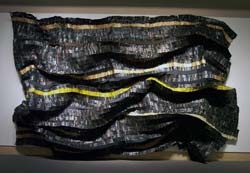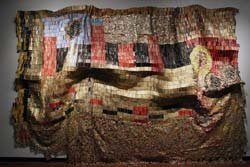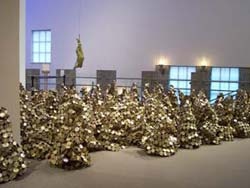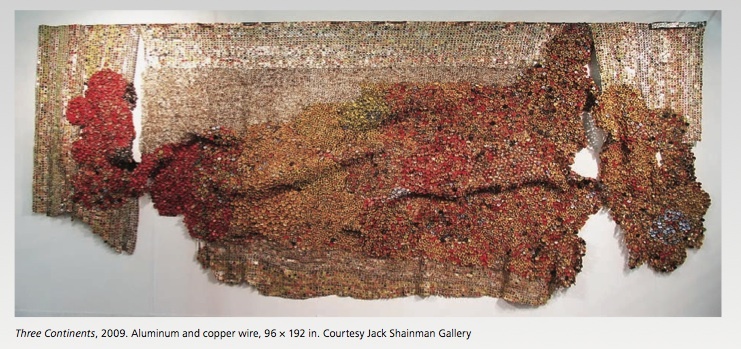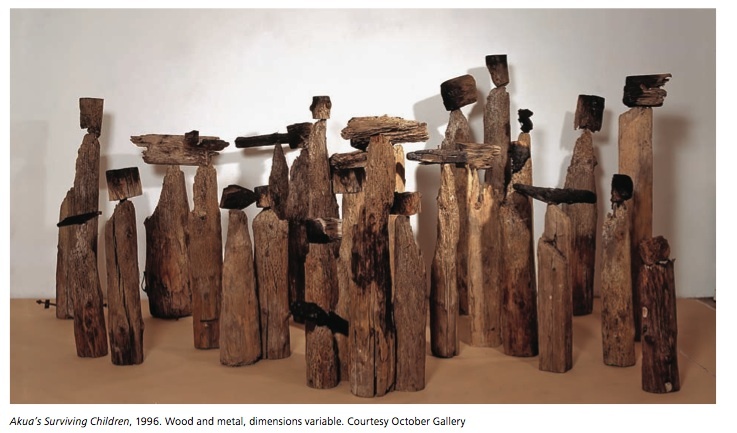El Anatsui, contemporary artist of Ghana
El Anatsui is one of the most famous Ghanaian artists in the contemporary African art world, known for his unique sculptures. It was his abstract wood sculptures that made him one of the most distinguished African artists, yet it would be his experimentation with scrap metals and recyclables that would skyrocket him to international recognition5. He was born in Ghana in 1944 before the country achieved independence in 1957, and has lived in Nsukka, Nigeria since 1975 and works as a professor of sculpture at the University of Nigeria, Nsukka. The traditions and culture of both of these countries has influenced El Anatsui’s works of art. Works of art such as West African kente cloth and reliquary carvings are both native to these nations and can be found in pieces by El Anatsui4.
In addition to the aesthetic value of his works, there are underlying themes that can be identified. According to a New York Times article by Alexi Worth, “one of the adinkra symbols, sankofa, is an image of a bird turning back towards its tail; its meaning is sometimes translated as ‘return and retrieve’ or ‘go back and pick’. To Anatsui and his peers, sankofa symbolized their effort to find useful traditions” from both where they originate, other places in Africa, and even from the western world5. Anatsui’s art “makes very specific references to his self-representation as an African and this attitude allies him with a tradition of experimentation in which contemporary African artists utilize indigenous concepts and symbols in their search for significant form”10. Lisa Binder, the curator in charge of the Anatsui exhibition at the Museum for African art mentions, “traditional African objects, unlike European paintings and sculptures, are often highly adaptable, designed to be reused”. Anatsui clearly lives up to the traditional African way and creates his treasures from other men’s trash. His creative ability allows him to influence the art market in ways that very few artists, let alone African artists, have been able to do.
In the 1970s, Anatsui began to work with broken ceramic fragments and used them to create his works of art11. These structures too had a deeper meaning in addition to their aesthetic beauty. The pieces had allusions to ancient Nok terracotta sculptures, West African myths about the earth, and cultural references to the use of clay11. The ceramic works depict the shattered and devalued histories to from an impressive new whole11. Anatsui also spent his time in this decade making sculptures that recombined signs and symbols in three-dimensional form, created by chopping, carving, burning, and etching wood. He was very well recognized for these wood structures in the African Art market.
Twenty years later in the 1990s, Anatsui “made a crucial shift from working with hand tools to carving with a power saw” which allowed him to cut through blocks of wood. This cutting would leave jagged surfaces, which he said were analogous to the scars left by the Europeans during the colonial encounters with Africa11. It wouldn’t be until his recent style of sculptures, the metal wall reliefs, that Anatsui, would achieve major international acclaim.
During the last decade, Anatsui has created intricate metal wall reliefs assembled from thousands of Nigerian liquor-bottle tops “into visual patterns of stunning sensory impact, transforming this simple material into forms that recall painting, sculpture, and tapestry, among other established art forms”11. These artworks, called Gawu, depict iconic wall reliefs that look like “medieval chain mail or jeweled robes fit for a king”4. This Gawu exhibition was originally organized by the Oriel Mostyn Gallery in Wales in 2003, toured in Europe, and then finally made its way to the United States. After five years in the United States, the works were then was relocated to the Smithsonian Museum4. On display are a few of Anatsui’s pieces that were created in the midst of his rises to international fame and exposure into international art circles4.
In the international art market scene, Anatsui is one of the more unique African artists because he is a successful African artist based in Africa and not the West like some other African artists. Only a few African artists have been able to “avoid the condescension of well-meaning Westerners” and eventually move out of the “atmosphere of benighted sympathy”4. Most of these artists typically relocate and make careers in the West, like Yinka Shonibare a British-Nigerian artist who resides in the United Kingdom. Considering the most influential and well-known contemporary artists, “Anatsui is exceptional not only being African but in being an African who has remained in Africa”4, a unique feat.
In this exhibition some of his works include:
Adinkra Sasa: Notably one of the darkest works in the exhibition. This relief contains hundreds of black labels woven in swaths. Adinkra is a traditional cloth that is typically used in funerals4. In this piece, Anatsui carefully crafts a work of art using “traditional weaving, minimalist sculpture, and references to the slave trade” and makes a very serious and solemn work of art.
Crumbling Wall: This 13 foot tall, 18 foot wide wall is made of rusting perforated plates that were used to grate cassava, a very common dish in the West African diet. "My concept of a wall is something that not only hides but reveals things," explains Anatsui. "Your eyes can't see behind it, but your imagination projects and your curiosity is aroused."
Many Moons: This is a multicolored wall relief that depicts a variety of techniques and patterns used to compose it.
Peak Project: One of the first pieces in this exhibition, this piece is a combination of 36, three-foot tall cones made up of golden lids from evaporated milk cans and resembles a mighty mountain range.
The largest North American collection by Anatsui is encompassed in his exhibit titled When I Last Wrote to You about Africa11. The collection is seen as a reflective look back on his 30-year career. Included are examples of his monumental wall hangings and floor installations, as well as acrylic paintings, ink drawings, from different time periods in his career. This showing in the United States is the first time that many of these works have been shown outside of Nigeria.
Some works in this exhibition include:
El Anatsui’s works on display in the Smithsonian National Museum of African Art “demonstrate the creativity at the heart of African resourcefulness”4. His sculptures have been made from a variety of unique materials like evaporated milk cans, cassava graters, and aluminum seals from the tops of liquor bottles. These distinctive works have achieved critical acclaim for their power and beauty4. Other Anatsui works are presently owned by the British Museum, and the Pompidou Center in addition to the Smithsonian4. Anatsui has also displayed his works in the 2007 Venice Biennale where the Metropolitan Museum of Art’s curator of Modern art was “blown away” by the wall hangings5. These pieces were quite different from the others that were present in that Venice Biennale. While most other things were pessimistic and depicted images of ruination, Anatsui’s works were uplifting5. This viewing of Anatsui’s Gawu exhibitions is considered by many to be his “break-out moment” in which he became an international name. By the end of 2007, a Sotheby’s auction had featured a reproduction of an Anatsui work. This truly marked that now “Anatsui had joined the big leagues”5.
The western art market has expanded with its new found appreciation for African works. Artists like Anatsui, Shonibare, Berni Searle, and more are gaining international fame and a greater following. The African presence in the art market allows the art world to expand. New artists, dealers, sellers, and buyers, marks a transformation and evolution within the art market. The art serves as gateway to a lifestyle and perspective that few Westerners truly understand. Newer artists, not to mention the unique styles each of these artists brings, may cause an emergence of a new era of art---an era that is marked by innovative genius, and a different style of creativity.
An interview with El Anatsui:
http://www.artinfo.com/news/story/34119/a-conversation-with-el-anatsui/
Videos of El Anatsui:
General Information about Anatsui: http://www.youtube.com/watch?v=vILNOM_Pe38
Interview with El Anatsui: http://www.youtube.com/watch?v=z271K6iqv8w
Installation of Anatsui’s work “Between Earth and Heaven”: http://www.youtube.com/watch?v=G7UBvknG8c4
References and Interesting Links:
2http://www.archives.gov/research/african-art/
3http://africa.si.edu/exhibits/gawu/about.html
4http://www.washingtonpost.com/wp-dyn/content/story/2008/03/20/ST2008032003103.html
5http://www.nytimes.com/2009/02/22/style/tmagazine/22nigeria.html?pagewanted=all
6http://www.artinfo.com/news/story/34119/a-conversation-with-el-anatsui/
7http://www.africansuccess.org/visuFiche.php?id=160&lang=en
8http://www.artnet.com/artists/el-anatsui/biography-links
9http://www.octobergallery.co.uk/artists/anatsui/index.shtml
10Picton J, Houghton G, Kawaguchi Y, et al: A Sculpted History of Africa. African Arts, 32:91-92, 1999.
11http://blantonmuseum.org/exhibitions/details/el_anatsui_when_i_last_wrote_to_you_about_africa/
